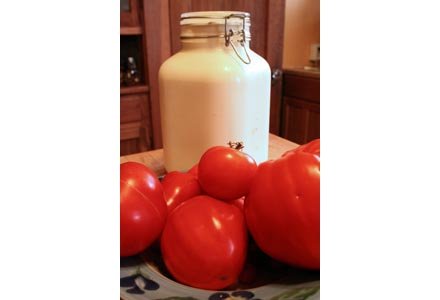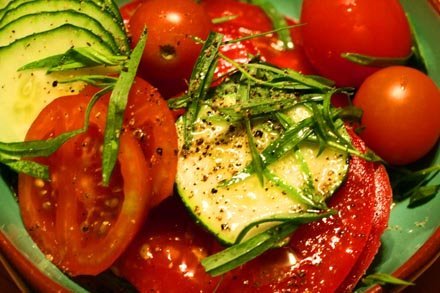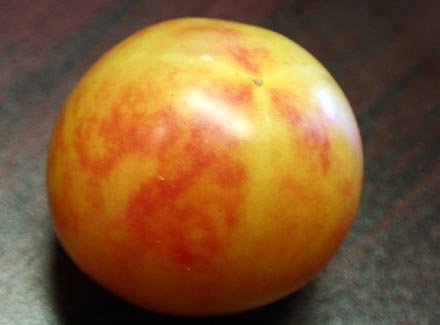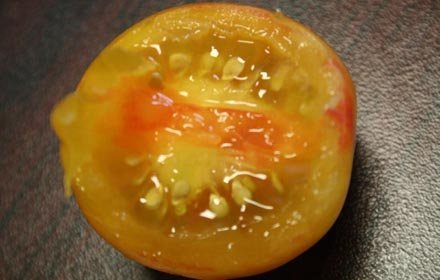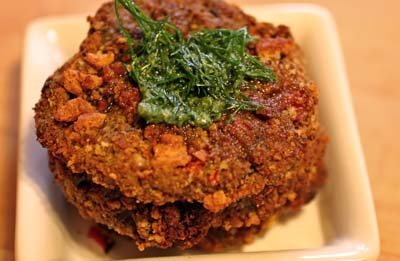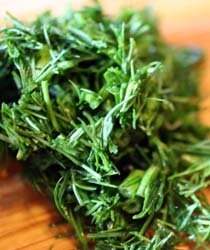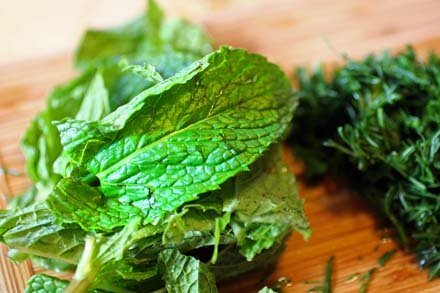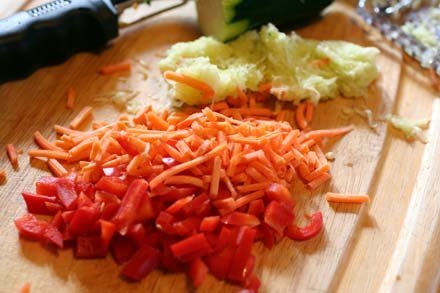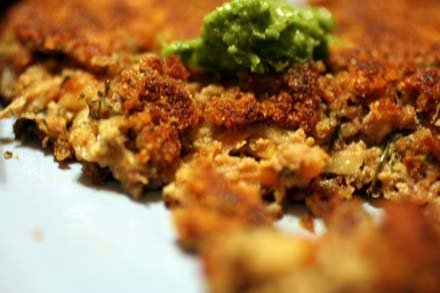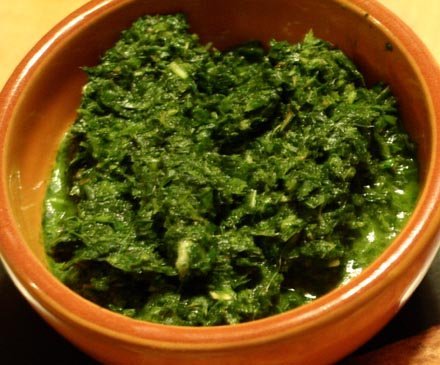
I try.
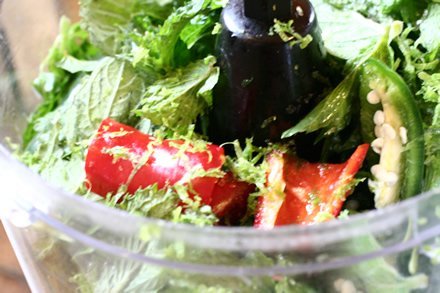
and try
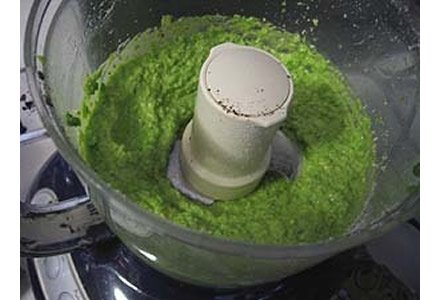
No matter. Makes no difference, the contemplation I give it, nor how I tweak the angle or shift the blinds to change the light, no matter what stool, phone book or chair I stand on, I just cannot snap an artful food processor pic.
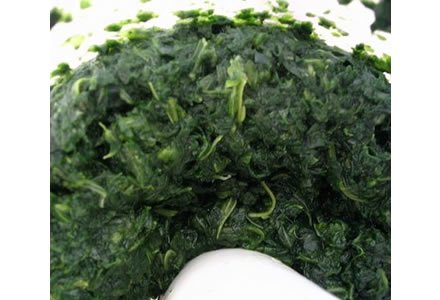
Burp does it. So does Lisa. Shutterbean could if she wanted to. And Heidi Swanson will probably have a book of them soon. But not me. (And you should picture me in my kitchen, trying. Because I do.)
I can, however, make a mint chutney that stops my Nepalese co-worker in her tracks. I just make sure to scoop it out of the food processor before serving.
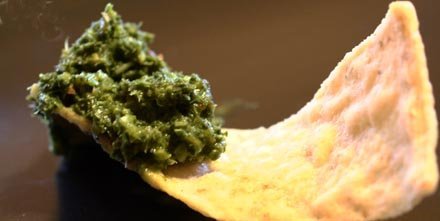
The recipe is short and sweet and the chutney is sweet, hot, zesty and bursting with phyto-nutrients, and right this very minute, if you walk out into your garden patch, I just bet you’ll be able to grab a handful of almost everything you need to make your own unbecoming-in-the-making-but-gorgeous-on-a-chip mint chutney. .
So, what do you do with it? Well, Simon and I practically eat it with a spoon but that’s not typical behavior. Neither, probably, is dipping tomatoes in it which is also what we’ve ended up doing, if only because it’s a race to eat all this garden goodness before it’s past the sell-by date. But hey, it works for us. It also works well with salty chips, baked or boiled potatoes, and (it goes without saying) na’an bread. People who eat meat say it’s a nice bright accompaniment to chicken and lamb, and it’s also right at home alongside fritters. And Cathy at Not Eating Out in New York made a gorgeous mint chutney potato salad. What creative uses am I missing though? Please let me know and hurry – the mint is on the basement stairs and climbing up!
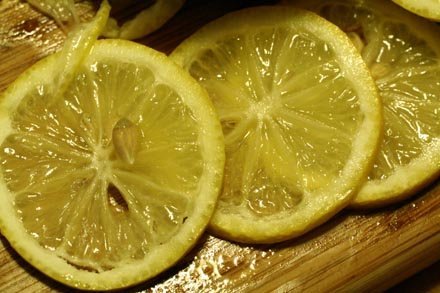
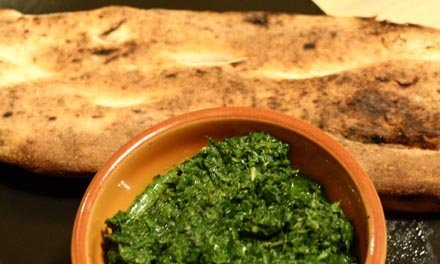
Mint Cilantro Chutney
Here’s a basic ratio (thanks to Ruhlman, I’m now thinking in them): two parts mint to one part cilantro, and for every two cups of herbs you want the juice and zest of one lemon. Use Meyer’s lemons if you can get them – they’re slightly sweet (you know, in a tart kind of way) and balance the heat and the mint perfectly. I don’t have to tell you to adjust the heat to your liking – use the chile seeds if you can take it, use half a chile if you’re tender-tongued. And if you’re like my mom, well, you don’t want to make this at all.
This time, Lucy had almost more to say than I did. Here’s her wine pick for mint chutney: Indian food is a tricky thing to pair and it is, by far, safest to stick with whites, more specifically whites from Alsace. With spicy food, very few areas consistently pair better. For something both spicy and herbaceous, Gewurtztraminer is always a safe bet. This grape with the daunting name (pronounced Guh-verts-tra-mee-ner) is seldom featured in restaurants with spicy food, I think, simply because no will order it lest they have to trip over the difficult Germanic name. Practice saying it at home 5 times and you will appear to be a wine genius the next time you go out. When you do order, look the waiter in the eye and confidently trill over the name. Trust me you will leave both friends and loved ones simply agog with your wine acumen. Other safe bets from that region include Pinot Blanc, Pinot Gris, Kabinett Reisling (any sweeter and you will choke on your naan), or a Muscadet (make sure you do not a get a dessert bottling). Rose also works well with spicy food. I cannot, in good conscience, recommend drinking red with a this pairing, but, if you simply must, stick to something with a low alcohol content as high alcohol wines tend to intensify heat on the palate. Your best bets for low alcohol reds that may work would come from France such as Beaujolais.

The Recipe
2 cups fresh mint leaves
1 cup fresh cilantro
Juice and zest of 1 ½ (or 2 – taste and see) Meyer’s lemons
1 fresh hot chile, seeded or not, and you pick the heat (I used a jalapeno because, despite all my bluster, I’m not as reckless as I pretend to be)
1 teaspoon turbinado sugar
½ teaspoon salt
Remove cilantro and mint leaves from the stems and discard the stems. Wash and spin dry the fresh herbs, then place them, along with the lemon juice and zest and the chile in a food processor. Run the processor until ingredients are pureed and well combined. Add the salt and sugar while the processor is running, then scrape down the sides and pulse a few more times. Face down your chile choice and dig in!
And here’s what else is going on in the garden (and, subsequently, in the kitchen, though it can’t count as cooking) these days. The small, mottled tomato is called Isis Candy, and it’s an heirloom that I haven’t seen before, though my seed-saving friend Steph knows them. I picked up the plant at an herb sale in April, and as the name suggests, Isis Candy is sweet and fruity, and when just ripened they have a bit of a bi-color yellow-red pattern going. Bitten into, the red becomes more like a haunting, a soft glow here and there. I don’t know anything about the variety though so if you do, please share.
The other golf-ball sized red tomatoes are some other kind of heirloom from the garden. Right now we have more tomatoes than we have kitchen time, but I’ll check my tags and let you know which was whcih.
The huge tomato is Lennie’s Oxheart, a hefty, meaty, low-acid slicing tomato. It’s incredibly productive in the garden this year. It, too, is an heirloom and the seeds are currently distributed by Seed Saver’s Exchange.
